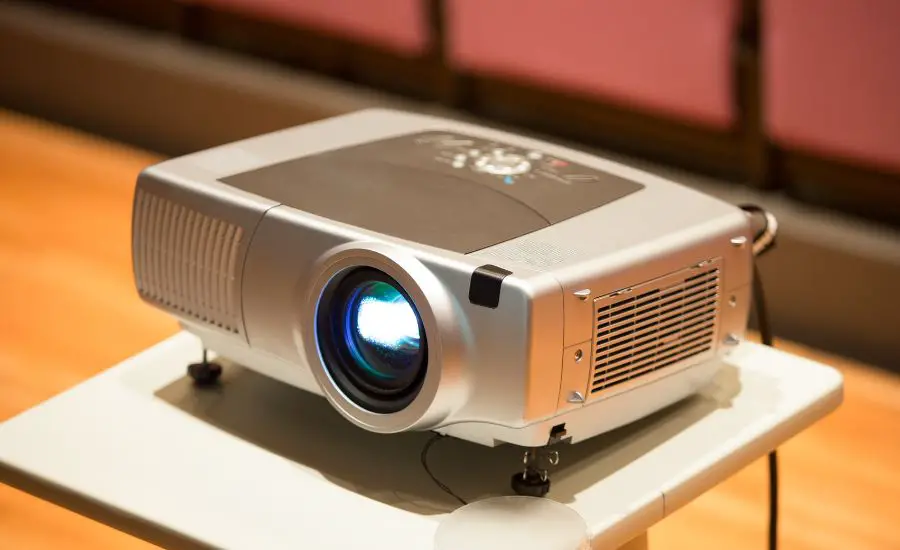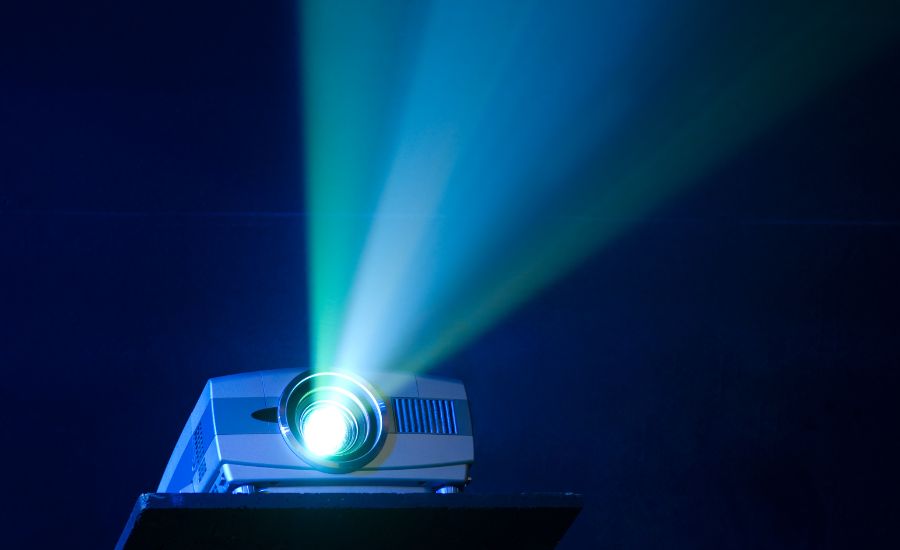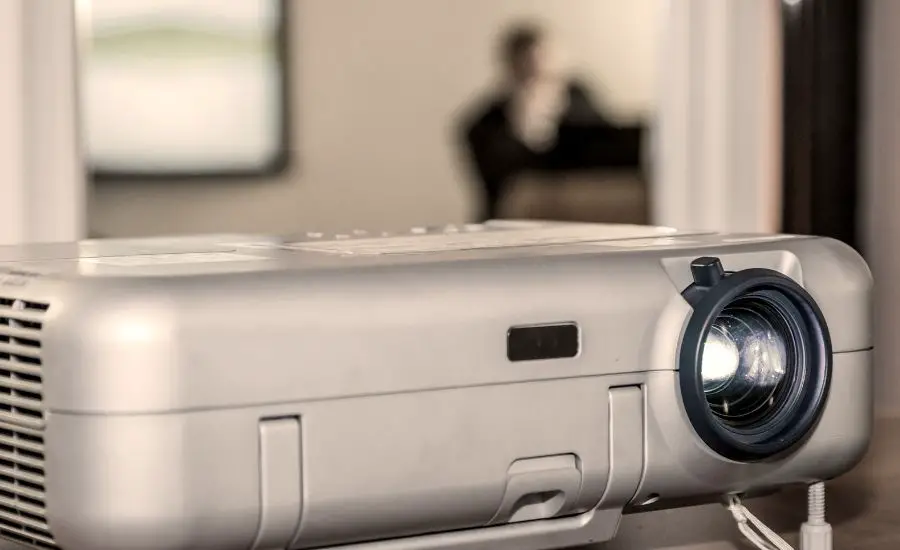In the realm of building home theater rooms, one question continually surfaces – “4K vs. 1080p projector: which is the right choice for me?” As technology advances and the demand for immersive entertainment experiences soars, the decision between these two projectors has never been more critical.
In this article, we’ll delve into the nuances of 4K and 1080p projectors, shedding light on what sets them apart and what factors matter most when deciding.
There’s no need for fancy comparisons or intricate descriptions here; we’ll keep it straightforward and informative, helping you make an informed choice for your home theater setup.

Understanding projectors
It’s crucial to lay the foundation by understanding what 1080p and 4K projectors are.
What is a 1080p projector?
A 1080p projector is a type of display device that’s designed to project images and videos onto a larger screen or surface.
The “1080p” in its name refers to projector resolution, which is a measure of how many pixels (tiny dots) make up the images it projects. In the case of a 1080p projector, it means there are 1,920 pixels horizontally and 1,080 pixels vertically on the screen.
This resolution is also commonly known as Full HD. It’s called “Full HD” because it provides high-definition images with sharp details and vibrant colors.
When you watch a movie or play a video game on a 1080p projector, you’ll notice that the images are clear and well-defined.
People often use 1080p projectors for various purposes, such as movies, playing video games, giving presentations, or even for home entertainment systems.
They’re known for their reliability and affordability, making them a popular choice for those who want a quality viewing experience without breaking the bank.
What is a 4K projector?
A 4K projector is a type of device used to display images and videos on a large screen. What sets it apart from other HD projectors is its ability to provide incredibly sharp and detailed visuals.
The “4K” in its name stands for the resolution of the images it can produce.
In simple terms, resolution refers to the number of tiny dots, or pixels, that make up an image. 4K projectors, also known as Ultra High Definition (UHD), have a sharper image resolution of 3840 x 2160 pixels.
This means it can display four times as many pixels as a standard 1080p projector, which has also a high resolution of 1920 x 1080 pixels.
The FULL HD resolution of 4K projectors results in a much clearer and more detailed picture.
When you watch something on a 4K projector, you’ll notice that even the tiniest details in the image, like individual blades of grass or the fine lines on a person’s face, are exceptionally sharp and lifelike.
What impacts a projector’s image quality
The quality of the projected image by a projector isn’t solely determined by its resolution (1080p or 4K). Several factors work together to shape the clarity and overall visual experience.
- Room size: the size of the room where you’re using the projector plays a role.
- Ratio of contrast: it refers to the difference between the brightest and darkest parts of an image.
- Viewing distance: how far you sit from the screen matters.
- Picture quality settings: most HD projectors offer various picture quality settings.
- Audio quality: while primarily related to sound, audio quality can indirectly affect your perception of image quality.
In summary, a projector’s image quality is influenced by factors beyond its resolution. It’s the interplay of content source, room size, higher contrast ratio, distance of viewing, picture quality settings, and even audio quality that collectively determine how crisp and immersive your projected images will be.
Understanding these elements can help you optimize your projector setup for the best possible visual experience.

Is the 4K vs. 1080p projector difference noticeable?
When it comes to choosing between a 4K and a 1080p projector, one of the most common questions that arise is whether the same image looks different between 4K and 1080 projectors and is it discernible to the naked eye.
To the average viewer sitting at a typical distance viewing, the difference may not be strikingly obvious. Both 4K and 1080p projectors can deliver sharp and clear images, especially on smaller screens or from a distance.
In simple terms, a 4K projector boasts a higher vertical resolution than a 1080p projector.
While 1080p offers 1,080 lines of resolution, 4K projectors nearly quadruple that with a whopping 2,160 lines.
On paper, this difference appears significant, but the real question is whether it translates into a noticeable visual distinction during your viewing experience.
In a nutshell, if you have a relatively small screen or sit a fair distance away from it, the disparity in resolution between 4K and 1080p may not be strikingly obvious.
With 4K projectors, the increased resolution allows for more intricate details and smoother transitions, creating a visually superior experience, particularly noticeable in scenes with fine textures or fast-paced action.
Factors affecting projector performance
We will delve deeper into the various elements that play a pivotal role in determining the ”4K vs. 1080p projector” comparison battle.
Streaming content
One of the key considerations when comparing 1080p and 4K projectors is the content you plan to stream. In the world of high-definition visuals, the resolution of the content you watch matters significantly.
Projectors with 1080p resolution are a solid choice for streaming most content available today. They provide crisp and clear marvelous images for a wide range of movies, TV shows, and online videos.
If you mainly stream standard HD content, a 1080p projector is often more than sufficient to deliver an enjoyable viewing experience.
When it comes to 4K projectors, they shine when you’re streaming content in native 4K resolution. These projectors can display content with four times the number of pixels as 1080p projectors, resulting in incredibly sharp and detailed images.
If you’re a fan of the latest 4K movies, gaming, or ultra-definition streaming services, a 4K projector is the way to go.
It’s important to note that while 4K projectors can upscale lower-resolution content, the true benefit is most noticeable when you’re streaming native 4K content.
Room size
1080p FULL HD projectors are a popular choice for smaller or medium-sized rooms. Their lower resolution can still deliver crisp and clear images in spaces where the distance of viewing is relatively short.
If you have a cozy living room or a bedroom that doubles as your entertainment space, 1080p laser projectors might be the ideal choice.
On the other hand, 4K projectors shine in larger rooms or home theaters with ample space.
The higher resolution of 4K projectors allows for a more significant big screen size without sacrificing overall image quality.
If you have a dedicated home theater room or a spacious living area, a 4K projector can provide a breathtaking cinematic experience, even on a big screen.
Contrast ratio
The ratio of contrast is the difference between the brightest and darkest parts of an image displayed by the projector.
Most 1080p projectors offer good contrast ratios, providing a satisfying quality of image for most home theater setups. They can render details in shadows and highlights reasonably well, offering a balanced viewing experience.
4K projectors, with their FULL HD resolution, often pair this with improved contrast ratios. This means they can display more intricate details in both dark and bright scenes. When watching 4K content, you’re likely to notice finer nuances and a greater sense of depth due to the superior contrast.
While both types of FULL HD projectors can deliver good quality images, 4K projectors typically have an edge when it comes to displaying the full spectrum of light and shadow, resulting in a more visually engaging experience.

Viewing distance
With a 1080p, the ideal distance of viewing is typically a bit farther from the screen. At a reasonable distance, say 8 to 10 feet away, the image produced by a 1080p projector appears sharp and clear to the human eye. If you sit too close, you might start to notice individual pixels or a slight lack of detail.
4K projectors, on the other hand, offer a substantial advantage when it comes to distance viewing. Due to their higher resolution, they allow for closer viewing without sacrificing image quality.
For a 4K projector, you can comfortably sit closer to the screen, often as close as 5 to 7 feet away, and still enjoy a crisp and detailed picture.
Picture quality
1080p LED projectors display images at a resolution of 1920 x 1080 pixels. This translates to over two million pixels on the screen, resulting in a clear and detailed image.
For most people, a 1080p projector provides a satisfying visual experience, especially in smaller rooms or when sitting at a standard distance of viewing. It’s a reliable choice for casual movie nights and everyday use.
On the other hand, a 4K projector boasts an impressive resolution of 3840 x 2160 pixels, offering over eight million pixels. This substantial increase in pixel count leads to a level of detail that can be truly breathtaking but at the same time uses more internet data for streaming.
In larger rooms or when viewing up close, the difference between 1080p and 4K becomes more noticeable. It’s particularly advantageous for those who crave the utmost clarity and realism in their viewing experience.
Audio quality
In the world of 1080p FULL HD projectors, audio quality can vary from model to model. Many 1080p projectors come equipped with built-in speakers. These speakers are often sufficient for casual viewing, such as watching TV shows or playing video games.
They can produce clear sound, but they may lack the depth and richness found in higher-end audio systems.
4K projectors, being a step up in projection technology, generally offer better audio quality. They often come with enhanced audio components, including more powerful speakers or support for external audio systems. This can result in a more immersive sound experience.

FAQ
Is a 4K projector worth it over 1080p?
The ”4K vs. 1080p” decision comes down to your specific needs. If you have a large room and access to 4K content, a 4K projector can deliver sharper images.
Does 1080p look better on a 4K projector?
Yes, 1080p content can look better on a 4K projector. When projected, 1080p content is upscaled, potentially resulting in a crisper image due to the 4K projectors’ ability to display more pixels.
Is a 1080p projector good for movies?
Yes, a 1080p projector is a great choice for watching movies. It provides high-definition imagery with sharp details and vibrant colors, making your cinematic experience truly enjoyable.
Do 4K projectors look as good as TVs?
They offer exceptional clarity and detail. However, ambient lighting and color vibrancy may not match the best TVs.
Read also: What Kind of Projectors Do Movie Theaters Use?
Conclusion
The choice between a 4K and a 1080p projector ultimately comes down to your specific needs and preferences.
While the visual distinction between 4K and 1080p projectors may not always be glaringly obvious to the naked eye, especially in smaller rooms or for casual viewers, it’s worth considering your room size, distance of viewing, and the type of content you plan to watch.
Ultimately, the ‘4K vs. 1080p projector’ debate is about finding the perfect balance between your budget, the quality of content you want to enjoy, and the space you have available.
Read also: Is IMAX Worth it? A Complete Review

